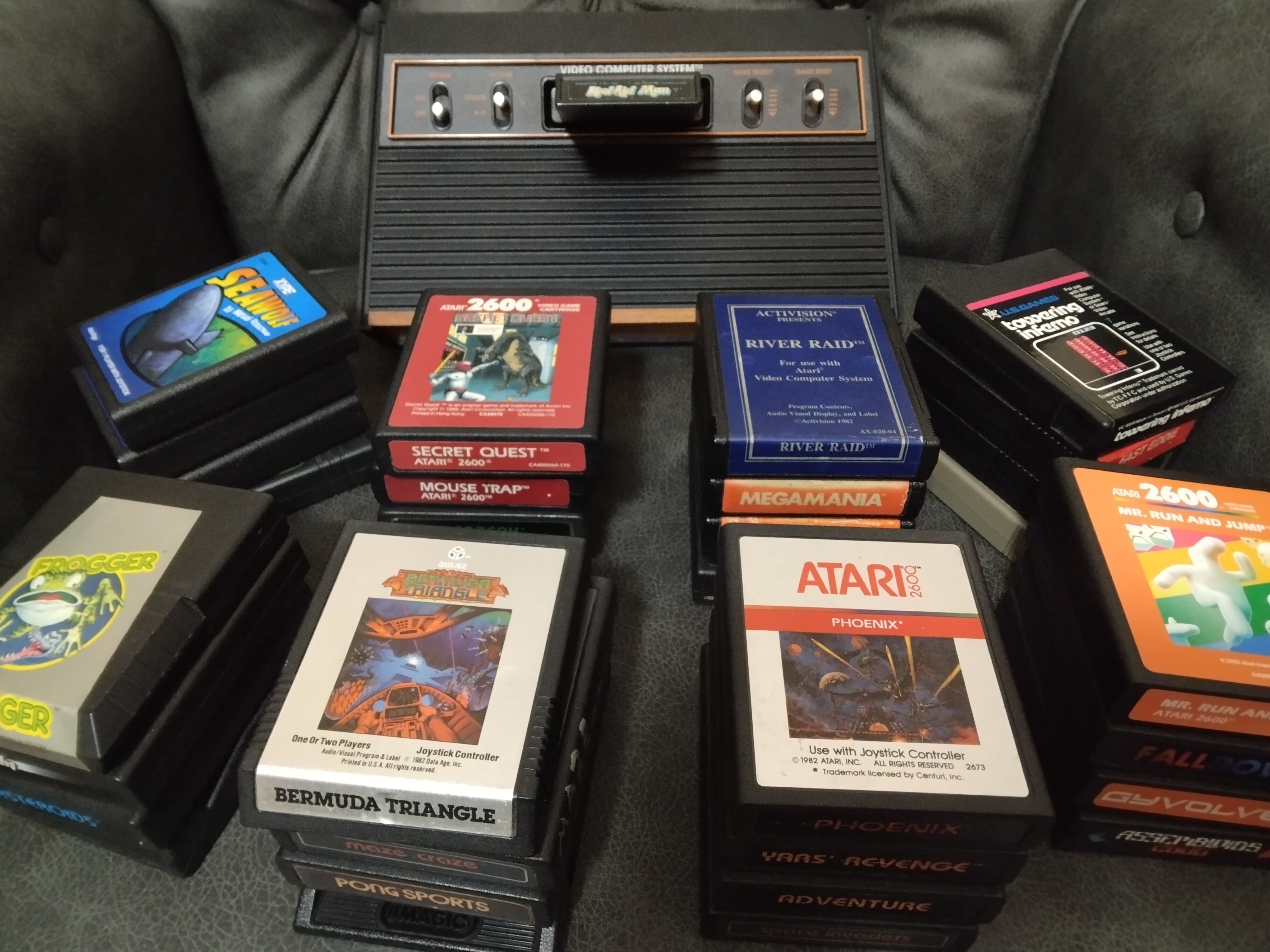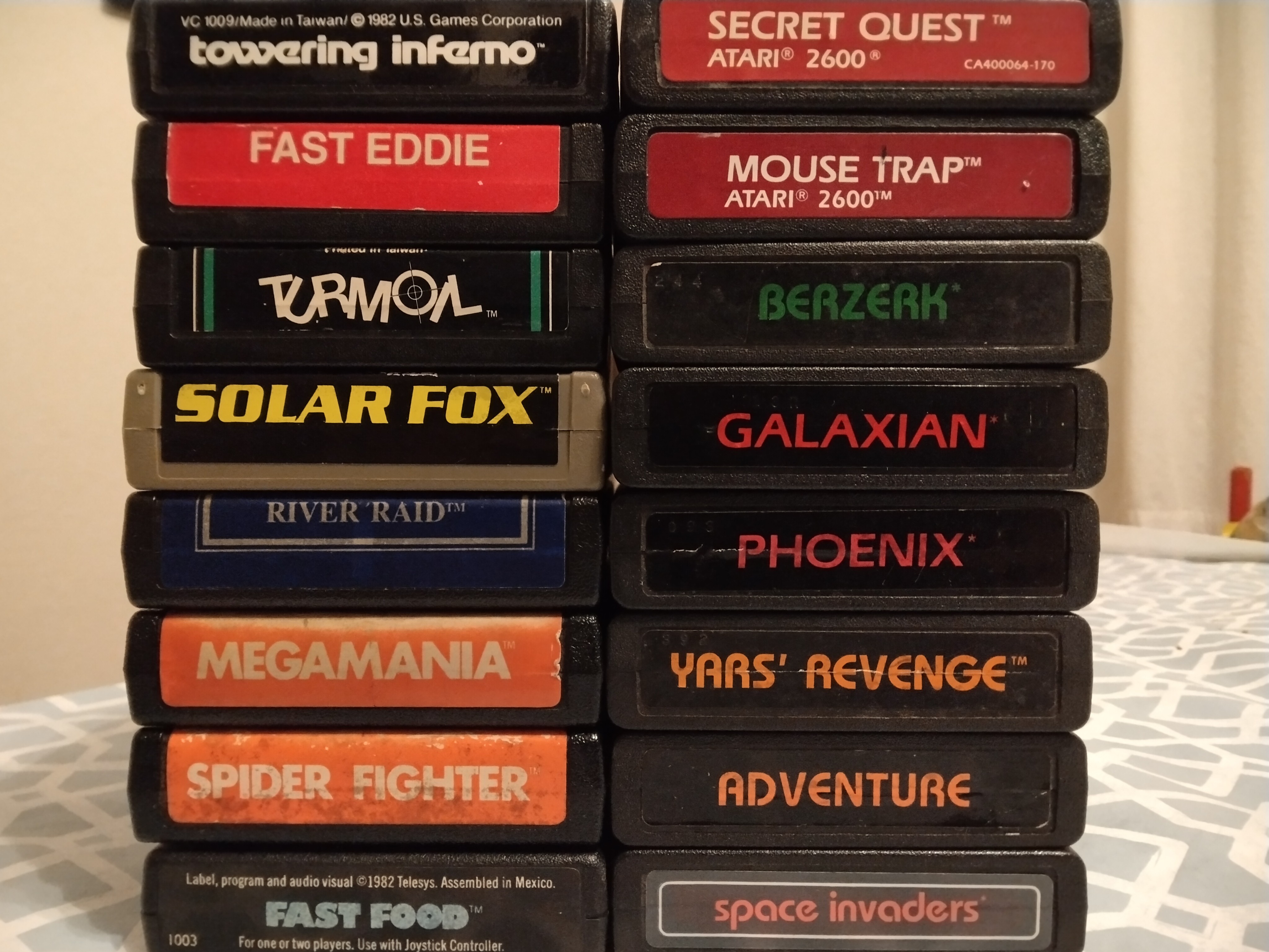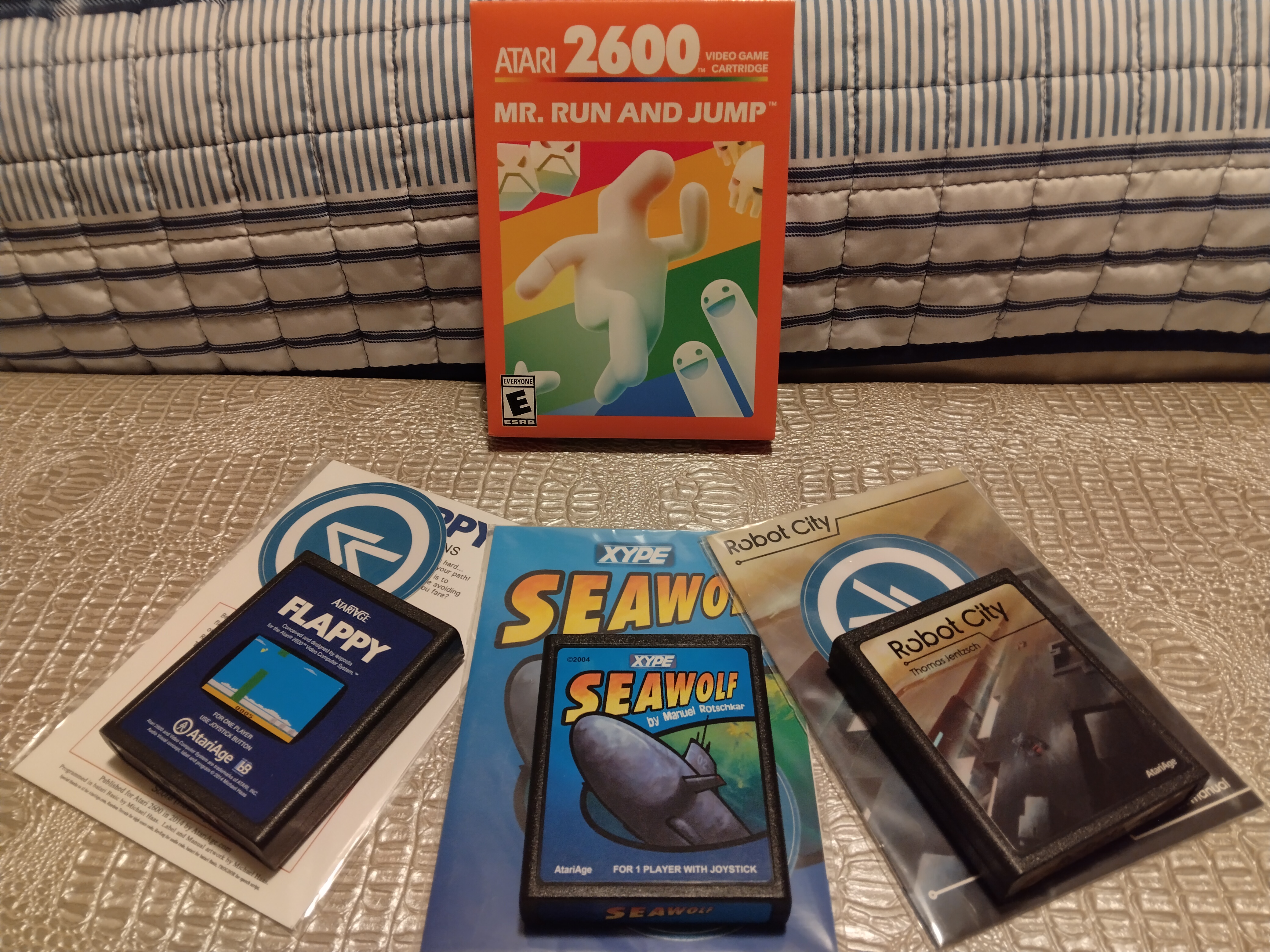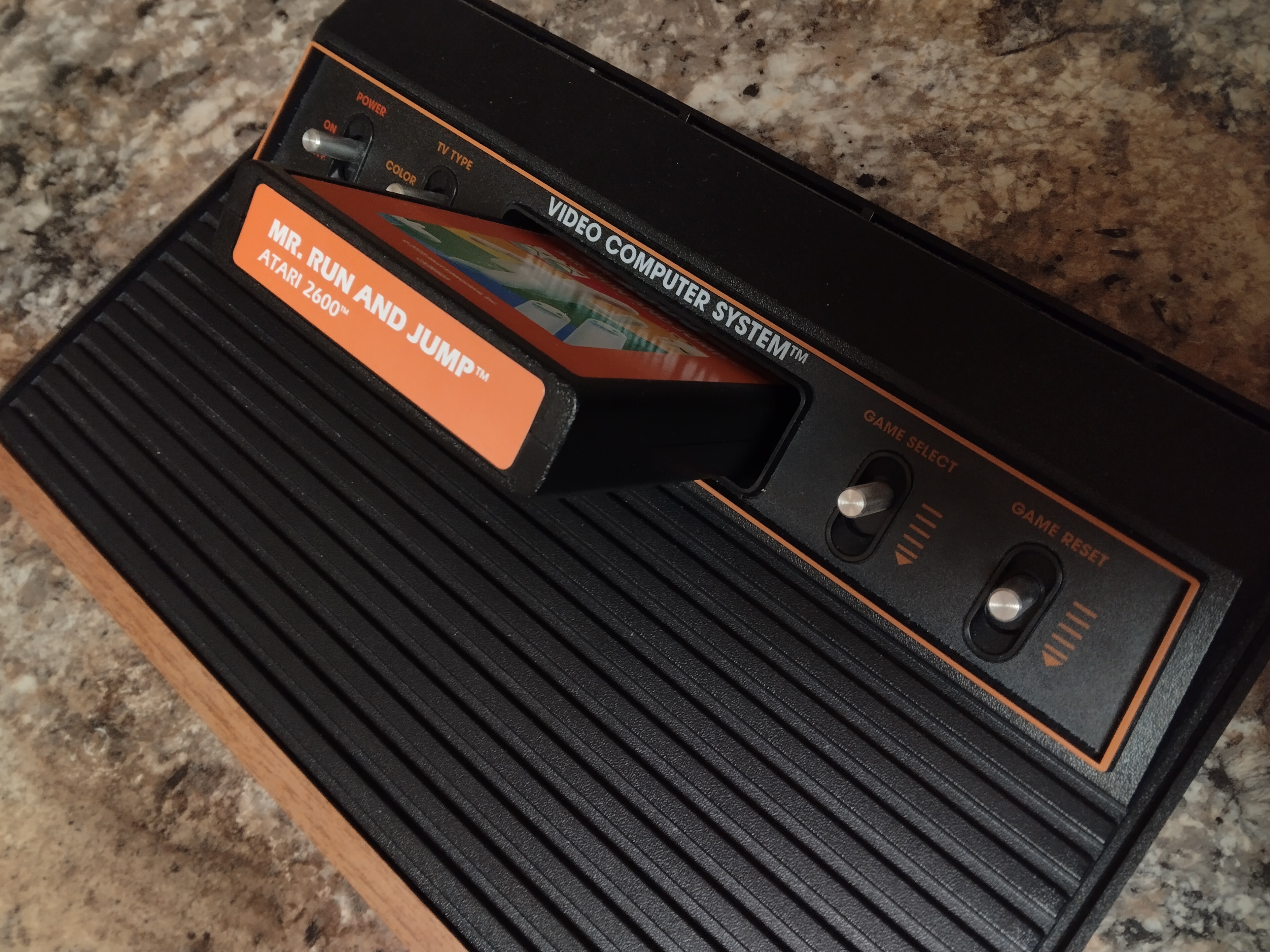
History
Click here to go back to the homepage!
---------------------------------------------------------------------------------------------------------------
The Atari 2600 is a console that I have always had a fondness for. I love it's history and how influential it was to the gaming industry, I enjoy the games and what developers were able to do with such limited technology, and I admire the community behind it and how they actively keep the system alive and growing even to this day. This console fascinates me on so many levels and I just want to take the time to admire everything about it.

History
The Atari 2600 was released back in 1977, and while not the first video game system, it was the first to really grab everyone's attention. The system was very cutback, it had a weaker version of a processor that was commonly used in computers at the time, and was so limited visually that essentially it could only have 5 sprites onscreen at once. (two player sprites, two missiles, and a ball sprite) Many games also lacked menus, so to choose a different mode or difficulty, you had to mess with the switches onboard for all of that. Still, developers used clever programming tricks and even bugs to get the most out of it's capabilities. With other limits, like the system only being able to read 4KB ROMs, Atari was able to use a method called bankswitching that allowed cartridges to come with more memory and just switch what was readable to the console at any given time.
At first, all games for the 2600 were made by Atari themselves. Other companies getting involved and making software for the system wasn't a thing yet. So games were either produced themselves from scratch, or were licensed and adapted from popular arcade titles to their console. Unfortunately, Atari didn't think that crediting their developers was necessary. Many of them disagreed and went off to create the first 3rd party developers like Imagic and Activision. This was done as the 2600 had no copy protection, so anyone with the skills and means to produce a cartridge could. Many other companies noticed this and decided to start making games as well. All without any input from Atari. Soon you saw games from 20th Century Fox, CBS Electronics, Parker Brothers, and even companies who had competing game systems like Coleco and Mattel made games for the Atari 2600. There was such a rush of games created for the system suddenly, that it was only a matter of time before things went south.
Because the Atari 2600 lacked any quality control measures, the system quickly got a reputation for having bad games. Ports like Donkey Kong and Zaxxon were nothing like their arcade versions, usually cutting out levels and making the system seem weak compared to other consoles on the market. The notorious porn games from Mystique further ruined Atari's reputation, making the systems look less family friendly and more like a device ran by toy makers gone rouge. Atari also contributed to this, with disappointing games like ET or the port of Pac-Man. These games did so poorly, that warehouses were piling up of these cartridges. This caused the company to take a massive nosedive, and as they were the market leaders, it caused the entire US video game market to crash in 1983. By then, almost all gaming companies went either bankrupt or switched to the growing home computer space. The 2600 essentially limped along until the NES came and revitalized the gaming market in the USA. After that, Atari re-positioned the 2600 as a budget system and both re-released old games along with creating a few new titles before terminating the system in 1992. The console, for better or worse, was very influential to the gaming industry. And even decades after everything happened, we still look at the actions from Atari as lessons to ensure we don't make the same mistakes again. And while many people see the system as a relic, the games available can still be entertaining and can even surprise you when taken a closer look.

Games
While the system is very primitive, the games for it are vast and really work within the limitations. One of the most common genre of games available are stationary shooters. Think of something like Space Invaders, where you play on the bottom of the screen and the enemies are above try to kill you. The formula is simple, but many games on the 2600 are able to put a unique spin on it. One of my favorites is Galaxian. Based on the arcade game by Namco, the enemies here will shoot and divebomb at you, making it more than just clearing an encroaching wave like other games. The playfield is also smaller than it's arcade version, which I feel makes it less punishing. (as you can only have one shot on screen at a time) Another similar game is Spider Fighter by Activision. This game is way more frantic, as multiple enemies will spawn from one enemy as it moves around the playfield. Thankfully, you can shoot multiple shots here, a rarity in 2600 games, which is fair as the enemies are much faster moving than in previous games. While the 2600 has a lot of games like this, other genres were also available as well.
An example of an early platformer is Fast Eddie by 20th Century Fox. The game takes place on a single screen, where you dodge enemies while collecting different items, such as hearts and tanks, till a key appears that will take you to the next level once obtained. The game is very easy to understand, and addicting as you try to get a higher score than your previous run. Another game that is interesting is Fast Food by Telesys. This game has you play as chatter teeth trying to eat as much food as possible while avoiding purple pickles. This game is very strange, but also humorous. You'll see a message popup saying You're Getting Fatter
in between levels, and the game will burp before announcing that the diner is Closed
once you eat too many purple pickles. It's such a strange game and I enjoy just how random it is. The Atari 2600 also more than just a place for unique concepts, it was also initiative in what a console game could be.
One thing that I find interesting is just how developers pushed the console beyond high scores and instant action. The game Adventure by Atari is often the most cited instance of this. The game was revolutionary as it introduced different concepts like going to different areas, having enemies and items exist beyond what you saw on screen, and having a win state. Compared to almost everything else released for the system, Adventure is more akin to what people expect from games today. Many say Adventure is Zelda before Zelda.
If that's the case, then Secret Quest would be Atari's response post Zelda. Released 9 years after Adventure, Secret Quest feels like the 2600's last stand at proving it's relevance. All on a 64KB cartridge, the game features multiple levels where you fight enemies in search of a password. Once you get the password, you must arm a bomb and proceed to an escape pod that will take you to the next level before it detonates. This game is more ambitious than anything released previously on the system, it even has a password system so that you can return to the last stage you played at a later time. The Atari 2600 was produced until 1992, and just as video games evolved, the 2600 did it's best to keep up. Yet even after it's initial run, there were many fans that would refuse to give up on the platform.

Community
The community around the system is what really keeps the console alive to this day. Websites like AtariAge, founded in 1998, have been one of the main hubs for the Atari community for years. The site is not only a resource for things like game manuals or technical facts of individual games, like the size of individual game ROMs, but it also has a form where a community of Atari enthusiasts have made tools to create their own games for the system. And not only will these games work on original hardware, but they can be sold on the website's store. You could also order some cartridges flashed with your game and sell/distribute them on your own. Users there will also help you with your code, and some will even design label art for your game. The idea of making my own game is something that I have been wanting to do for a while. And thankfully, testing said games is easier than ever thanks to the communities efforts in emulation.
Like other consoles, there is a program out there that can run 2600 games on devices that aren't a 2600. This is done with Stella, an emulation program released in the mid 90's. This program makes it not only possible to play Atari 2600 games on things like PC, but it also has debugging tools that let you see what the game code is doing. You can see how developers were able to stretch out 2 enemy sprites in a way that made it look like 36 in the case of Space Invaders, or how you could use things like the ball sprite to add detail to a character sprite, like how it was done in Master Chief's visor in the homebrew game Halo 2600. The program is so extensive in it's versatility that it really is the perfect digital Atari 2600. It's a good thing too, as the current form of Atari has recognized it along with the community behind it and have essentially resurrected the system for the modern age.
During the 2020's, modern Atari has been catering to it's fans in ways that I haven't seen another company do. The biggest of these attempts has been the release of the Atari 2600+ and later the 7800+. Both are revisions of their respective systems that, using emulation along with modern components like HDMI and USB C for power, make it possible to enjoy these games on modern displays. I have the 2600+ myself, I even pre-ordered it when it was announced in 2023. And while at first the system was a bit wonky, thanks to system updates from users at AtariAge, the console can now play almost all 2600 and 7800 games with no issues. And since the 2600+ also has the same switches that the original 2600 has, you get that real interactive experience of playing the games like you would on an original system. Atari has also been taking games that were previously homebrew games and essentially making them official by publishing them. This turns fan games or unofficial enhanced versions into official products under the Atari name. And the idea that a game I made could be recognized by Atari and brought into their catalog is so amazing. It's a thing that only a few companies like Sega or Valve have done in the past, and I'm glad that Atari can be added to that list.

Conclusion
The Atari 2600 is a console that continues to surprise me decades after it was released. From the history both of the console and the industry that it created, to the games that worked within the limitations to be as fun as possible, and to the community that has kept it alive years after it's discontinuation, the 2600 is a system that will never cease to amaze. It survived the video game crash of 1983, and I have no doubt that it will continue chugging along for many more years to come.
---------------------------------------------------------------------------------------------------------------
Click here to go back to the homepage!
